A Guide to Types of Tofu and What to Do With Each of Them
A guide to identifying, shopping for, and preparing just about every kind of tofu you'll find in stores.
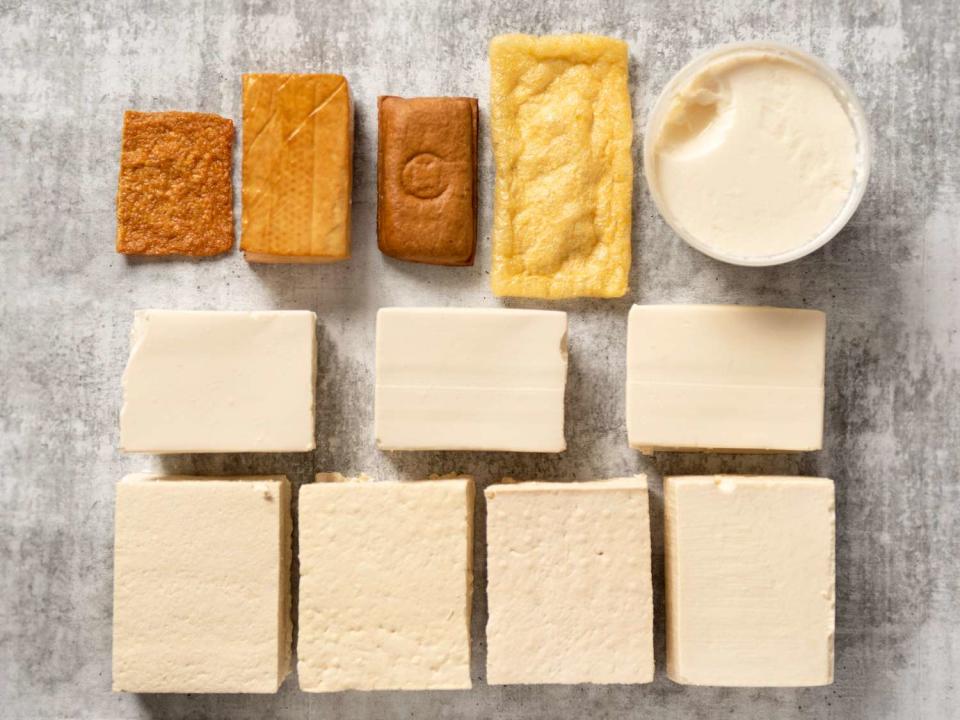
Serious Eats / Liz Clayman
Tofu: Either you love it, or you haven't had it prepared well. The jiggly soybean product has been around for eons—William Shurtleff and Akiko Aoyagi's History of Tofu and Tofu Products digs up a mention of tofu in a Chinese text dating to AD 950. Buddhist monks spread the good word about tofu across Japan and Korea, and a few centuries later, the protein made its way to the US. (Fun fact: Benjamin Franklin is the earliest known American to write about tofu, in a letter mailed—with soybean samples—from London to Philadelphia in 1770.) Packaged tofu cakes hit American grocery stores in the late 1950s, packed in water-filled, heat-sealed plastic bags. But tofu wasn't exactly an instant hit.
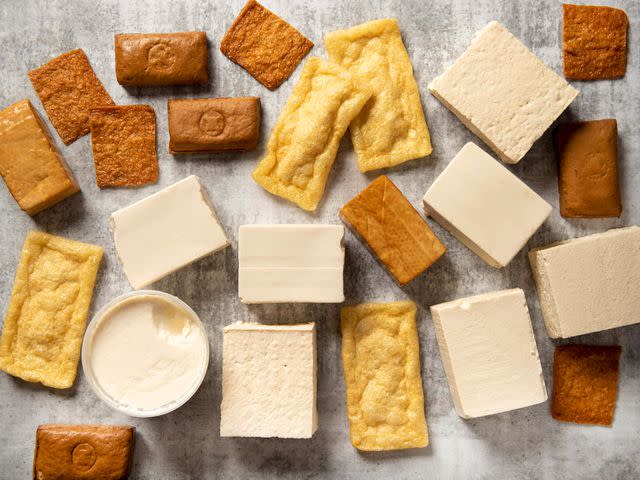
Serious Eats / Liz Clayman
But what is tofu, anyway? It's soybean milk—not from fuzzy green edamame pods, but from mature white soybeans—boiled, curdled, and pressed, similar to dairy cheese. The soybeans are soaked and ground into a slurry, which is warmed with water, then strained to become soy milk. This milk is combined with a coagulant—traditionally nigari, the dried liquid (mostly magnesium chloride) that remains after common table salt has been removed from seawater. Other coagulants, such as magnesium chloride, calcium sulfate, or magnesium sulfate, can be used as well. The soy milk and coagulant are simmered until the curds and whey separate, then placed into cloth-lined molds and pressed until the whey drains out. The length of pressing time is relative to the quantity of curds and the desired firmness; it averages around 15 to 20 minutes. The longer it's pressed, the more whey is released, and the firmer the finished product will become.
Prep Methods
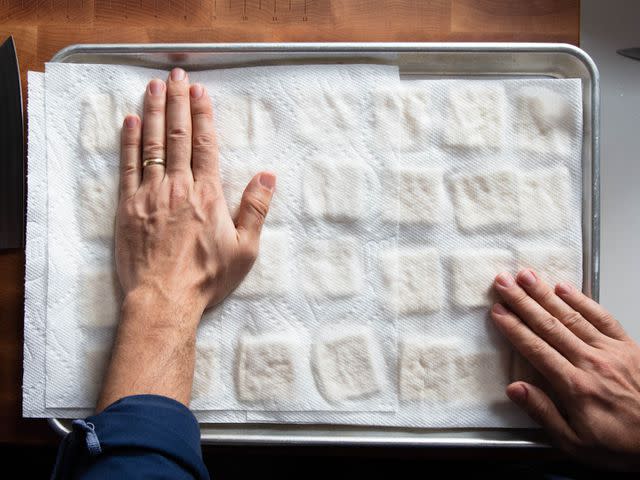
Serious Eats / Vicky Wasik
During its introduction to the US, tofu was mildly misunderstood by some and downright reviled by others. Its reputation for being bland and boring led most American families to shy away from the wobbly blocks. As recently as 1986, tofu was declared America's most loathed food. But the misunderstanding between Americans and tofu has eroded in recent years. In fact, tofu—high in protein, low in cost, and easy to work with—has come to endear itself to our country. Today, it's widely accepted, and commonplace at many restaurants and groceries, where shoppers have a vast array of tofus to choose from.
Before we get into all of the different kinds of tofu, let's take a minute to review some of the steps you should take to get your tofu ready for action. Because tofu has a high water content, it's wise to remove excess liquid to avoid diluting flavors or causing explosive frying incidents.
For Eating Raw: Pretty straightforward. Soft and silken tofu are ready to go right out of the package (though, technically, any tofu can be eaten raw). Drain off the excess water, and eat up!
Draining/Blotting: For block tofu, I like to slit the package and drain out the packing water. At a minimum, all tofus (except the silkens—more on them in a minute) should be drained by placing them on an absorbent surface, such as layered paper towels or a dish towel. Often five to 10 minutes will suffice; use this time to assemble your other ingredients.
Pressing: This is the most common prep step in most tofu recipes. A block of medium to extra-firm tofu is sandwiched between dish towels (waffle-weave towels work best!) or paper towels. Place a flat surface on top, such as a dish or baking sheet, and weigh it down with a heavy item (28-ounce tomato cans are extremely well-suited for this job).
Salt-Soaking and Draining: If pressing seems too complicated, you can bypass that step with a 15-minute soak in salt water. I was introduced to this technique through Andrea Nguyen's book Asian Tofu. She promotes it as a way to pre-season the tofu and create a crispier crust and texture. The soaking is followed by draining the tofu on a dish or paper towel.
Freezing: You can just freeze a whole block of tofu, but it's convenient to cut it into the sizes you want beforehand. Almost all the moisture will be pulled out, compacting the curds and extracting the whey, leaving behind a spongy product that greedily absorbs sauces. Frozen tofu can be defrosted in the fridge or microwave, or tossed into boiling water—boiling may sound counterproductive, but after freezing, the curds are so compact and the water pockets so enlarged that liquid drains freely from the tofu with a gentle squeeze. I find it's best to drain and/or press the tofu first, or else you'll end up with a huge icy block.
Marinating: One the biggest myths about tofu is that it soaks up the ingredients around it. This is only true with hyper-porous frozen tofu. Unless you have six hours to sous-vide the tofu and completely transfuse the internal moisture content, don't expect a lot of flavor from a marinade. This myth was publicly busted in Deborah Madison's book This Can't Be Tofu!, in which she champions the glazing method to infuse tofu with flavor. To glaze, pan-fry the tofu—with or without oil—until golden. Then add a marinade, so that the fried exterior soaks up the flavors and the heat of the pan reduces the sauce to a clingy syrup.
Now, on to the tofu types!
Block Tofu
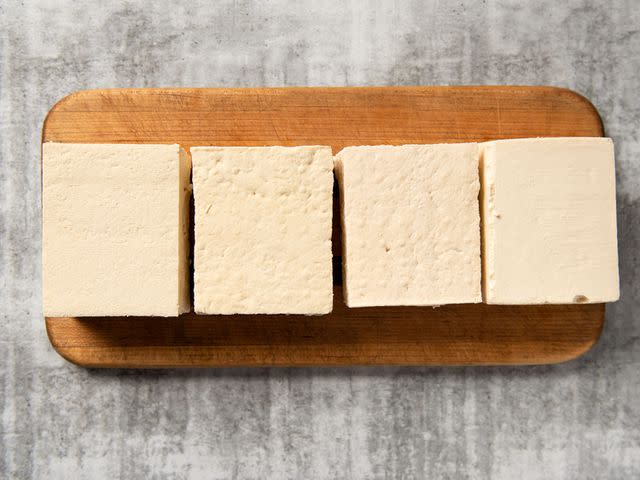
Serious Eats / Liz Clayman
Block tofu is what you'll find most often at grocery stores and restaurants. Made using the curds-and-whey method explained above, it is sometimes referred to as "cotton tofu" due to the fluffy texture of the curds. You'll find block tofu sold packed in water in plastic trays—a commercial-friendly storage method developed in 1966 by Shoan Yamauchi in Los Angeles.
Soft Block Tofu
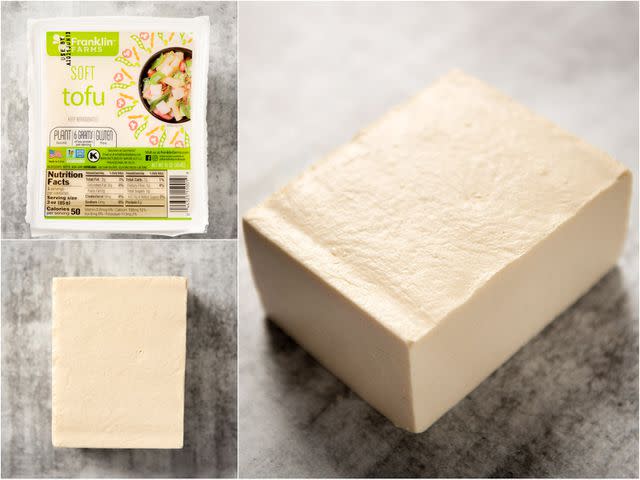
Serious Eats / Liz Clayman
Soft tofu is pressed for the least amount of time of all the block tofus, allowing the curds to blend seamlessly into the remaining whey. This smooth block still has texture when broken up, as it often does with mild handling. It has a delicate body, similar to Jell-O, and a mild, milky flavor. Its similarity to soft desserts makes soft tofu a great neutral base for a sweet element; it works equally well in savory dishes. Because it has a high water content, soft tofu is not recommended for shallow-frying—the sputtering and spit-back can be dangerous. But battering and deep-frying—a method that fully envelops the cubes—produces wonderfully tender nuggets of soybean bliss.
How to Prep: Pressing soft tofu is not recommended, as you will end up squishing it. It is best drained/blotted and raw.
Best Uses: Raw, puréed, boiled, or battered/deep-fried.
Soft Block Tofu Recipes:
Almond Tofu Ice Cream With Honey Swirl
Squash, Shiitake, Kale, and Kimchi Stew
Medium Block Tofu
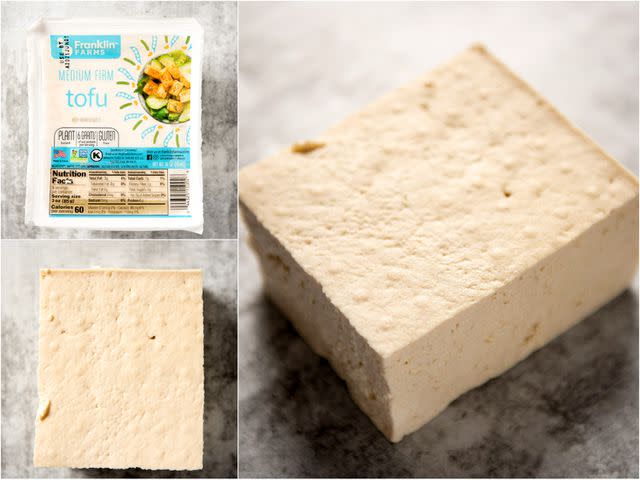
Serious Eats / Liz Clayman
Medium-firm tofu has a rougher texture than soft—the curds are visible—but will still crack with handling. It can have a droopy appearance due to its moderate moisture content, and it's a good choice for dishes that don't require much manipulation, like braising or boiling. Because there's more whey in medium-firm tofu, it may break up during vigorous stir-frying, and pan-frying can lead to sad, deflated tofu planks.
How to Prep: Pressed, drained, salt-soaked, or frozen.
Best Uses: Battered, stir-fried, baked, and fermented.
Medium Block Tofu Recipes:
Citrus-Marinated Tofu With Onions and Peppers
White Tofu, Sesame, and Vegetable Salad
Chilled Tofu With Crunchy Baby Sardines
Firm Block Tofu
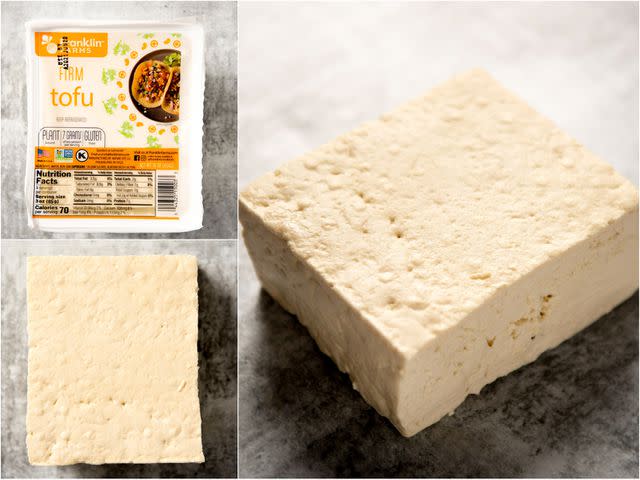
Serious Eats / Liz Clayman
This is the workhorse of the tofu family. If you're not sure which tofu to buy, a firm block will get you through most savory recipes. The curds in a firm block are tight and visible; it should feel solid, with little give. Its firm body takes on a slight rubbery texture during cooking, which means you can handle each block with (relatively) little fear. Firm tofu holds up quite well to frying and stuffing.
How to Prep: Pressed, drained, salt-soaked, or frozen.
Best Uses: Battered/crusted, baked, boiled, pan-fried, stir-fried, deep-fried, glazed. Like I said—it's versatile.
Firm Block Tofu Recipes:
Cantonese-Style Tofu, Pine Nut, and Jicama Lettuce Cups (San Choi Bao)
Tofu and Kale Salad With Avocado, Grapefruit, and Miso-Tahini Dressing
Easy Vegan Crispy Tofu Spring Rolls With Peanut-Tamarind Dipping Sauce
Grilled Tofu With Chipotle-Miso Sauce
Phat Phrik Khing With Tofu and Long Beans (Thai Dry-Curry Stir-Fry)
Mushrooms and Tofu With Chinese Mustard Greens
Extra-Firm Block Tofu
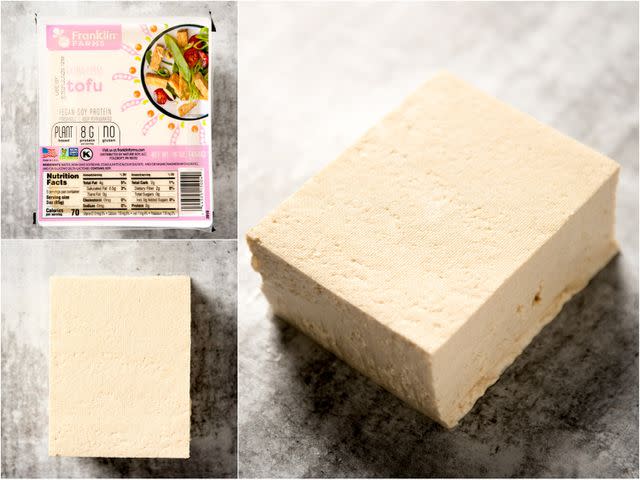
Serious Eats / Liz Clayman
This is the most compact of the block tofus. The curds are tight, and the block is noticeably squatter than all others. Its texture has the most chew, making this the tofu best suited to heartier dishes. It makes an ideal dairy-free substitution for paneer in Indian recipes, and it's our tofu of choice for making crispy tofu worth eating.
How to Prep: Pressed, drained, salt-soaked, or frozen.
Best Uses: Battered/crusted, baked, boiled, pan-fried, stir-fried, deep-fried, glazed.
Extra-Firm Block Tofu Recipes:
Creamy Vegan Saag Paneer
Crispy Stir-Fried Tofu With Broccoli
Vegan Chorizo for Omnivores
Crispy Kung Pao Tofu
Grilled Lemongrass- and Coriander-Marinated Tofu Vietnamese Sandwiches (Vegan Banh Mi)
Banh Mi Panzanella
Silken Tofu
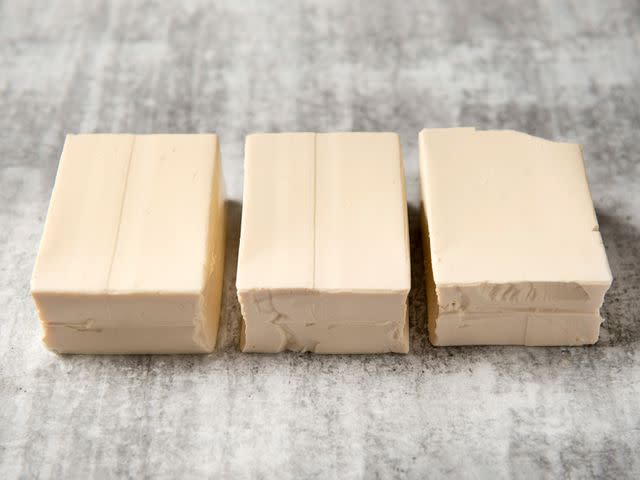
Serious Eats / Liz Clayman
Silken tofu is the next most common tofu style. It's made in a similar process to block tofu, except that the soy milk is coagulated without curdling the milk. It's also left unpressed, so every cake retains all of its moisture while cooling. Because curds never form, the tofu—be it soft, firm, or extra firm—has a smooth and "silky" appearance. More delicate than block tofu, silken tofus likewise require delicate handling, lest they fall apart.
Soft Silken Tofu
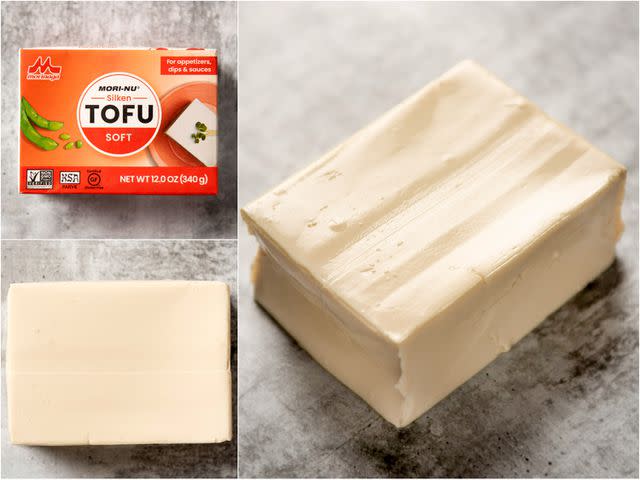
Serious Eats / Liz Clayman
Delicate and heavy, soft silken tofu falls through your fingers under its own water weight. It requires the careful handling of a poached egg, and will break like one if manipulated too much. It is particularly suited to saucy recipes, such as dressings, smoothies, and egg or yogurt substitutions.
How to Prep: Raw, drained—do not press or freeze.
Best Uses: Blended, room-temperature, battered, sauce.
Soft Silken Tofu Recipes:
Vegan Mayonnaise
Warm Silken Tofu With Celery and Cilantro Salad
Vegan Carbonara Pasta
Silken Tofu With Spicy Sausage
Soondubu Jjigae (Korean Soft Tofu Stew)
Turkish-Style Vegan Tofu Scramble (Vegan Menemen)
Vegan Migas (Mexican-Style Fried Tortillas With Tofu)
Firm Silken Tofu
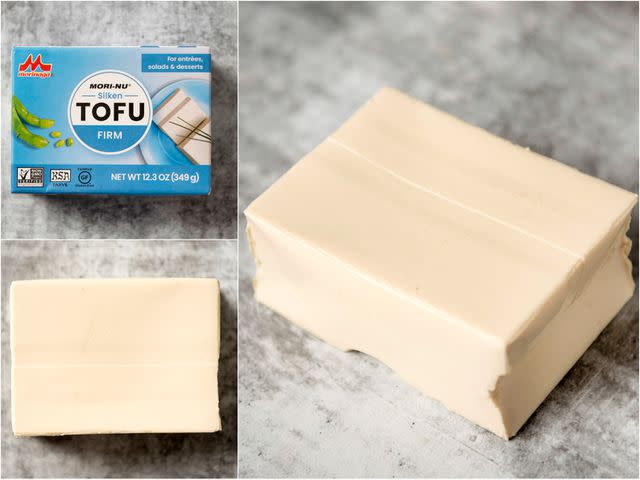
Serious Eats / Liz Clayman
Firm silken tofu should never be confused with or substituted for a firm block tofu. It also shouldn't be confused with soft silken tofu—firm silken is made from a denser soy milk, meaning less water is added during the production of the milk. Firm silken tofu has a richer body that holds up better to handling. It's ideal for dishes in which the silken tofu will be cut into and/or suspended in sauces while retaining its shape.
How to Prep: Raw, room-temperature—do not press or freeze.
Best Uses: Boiled, battered, lightly fried, fermented
Firm Silken Tofu Recipes:
Real-Deal Mapo Tofu
Vegan Mapo Tofu
Rustic Miso Soup With Tofu and Seaweed
Extra-Firm Silken Tofu
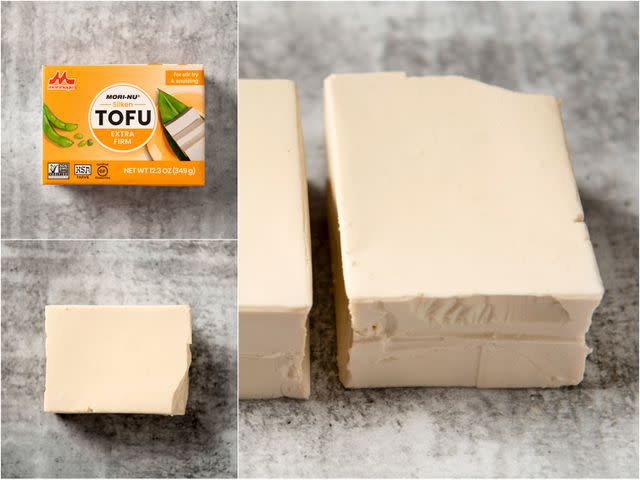
Serious Eats / Liz Clayman
For most intents and purposes, extra-firm silken tofu is exactly the same as firm silken.
Fresh Silken/Custard Tofu
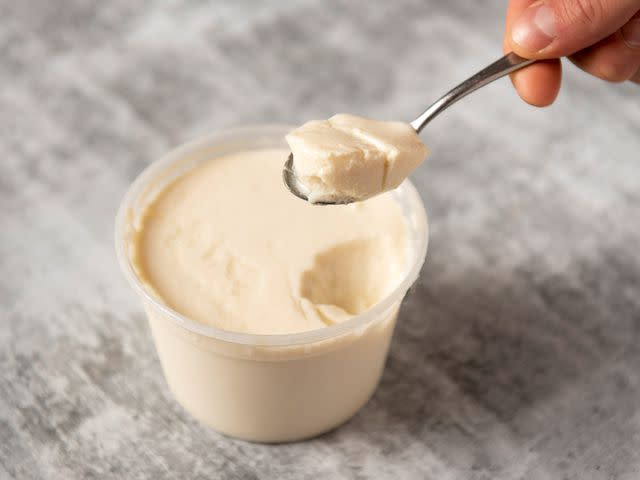
Serious Eats / Liz Clayman
Fresh silken/custard tofu is best for the most delicate dishes. Because custard tofus are consumed with minimal preparation, your best bet is purchasing them fresh from a local manufacturer. Even the most prettily packaged mass-produced ones taste flat and bitter. But if you can find a reliable local source, the light, slightly sweet, and milky character of a fresh silken/custard tofu is out of this world. Purchase fresh silken/custard tofu right before you need it, as this tofu turns quickly. When you see a pink/orange hue glaze the surface—which can happen as quickly as the next day—toss it. It's so delicate that the quality shouldn't be overshadowed by a complex preparation—use a soft silken or block tofu for that.
How to Prep: Raw.
Best Uses: Spoon into a bowl, ladle some miso/dashi broth over it, and sprinkle with finely sliced scallions for a light savory dish. Or drizzle with agave for a sweet treat.
Advanced Studies
Dry/Gan/Five-Spice Tofu
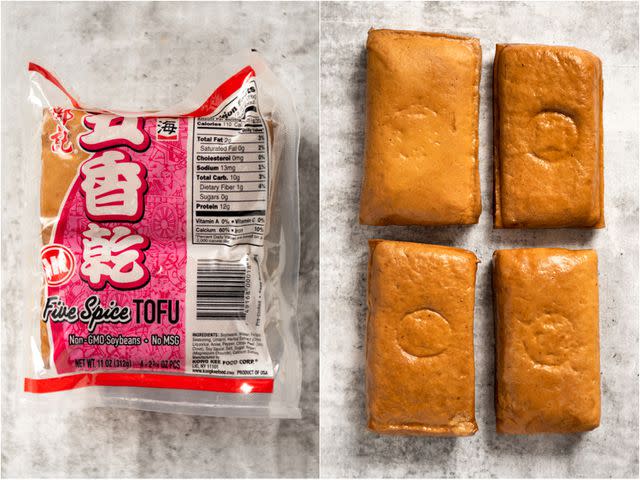
Serious Eats / Liz Clayman
This is my personal favorite tofu style. The ultra-dense block is stained a deep purple/brown with seasoning (usually Chinese five-spice powder), and it's baked and compacted into tight cubes. It closes the circle of tofu preparation techniques, as a dry tofu—like soft silken—requires little to no cooking. On its own, dry tofu has a flappy/rubbery feel, but its chewy texture plays well with anything soft. Chop it up, toss it into a noodle or brothy curry dish, and enjoy.
How to Prep: No prep needed; simply remove the package and go.
Best Uses: Any dish in which you want a chewy texture.
Dry/Gan/Five-Spice Tofu Recipes:
Stir-Fried Green Beans and Five-Spice Dry Tofu
Pan-Fried Vegetable Dumplings
Stir-Fried Chow Mein With Four Vegetables
Smoked Tofu
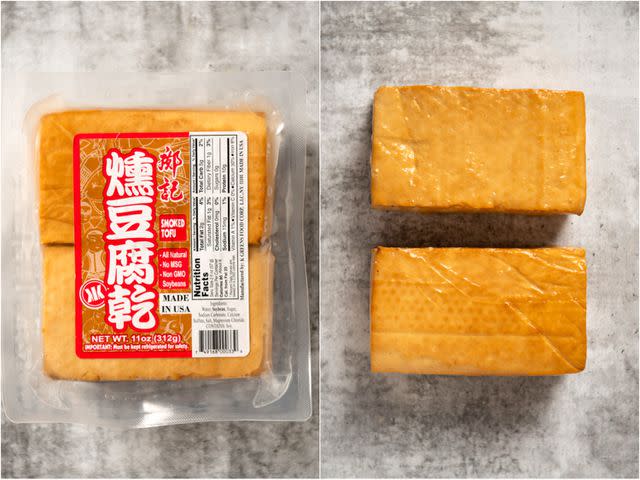
Serious Eats / Liz Clayman
This extra-firm tofu is most often smoked in tea leaves, giving it a light hue and smoky flavor. It's so dry and dense, you can barely see the curds, and is very similar to dry tofu, but with a lighter up-front flavor. This tofu is tough—you could play a game of catch without it breaking.
How to Prep: No prep needed; simply remove the package and go.
Best Uses: Any dish in which you're looking for a smoky flavor and chewy texture.
Smoked Tofu Recipes:
Sichuan-Style Asparagus and Tofu Salad
Aburaage and Inari
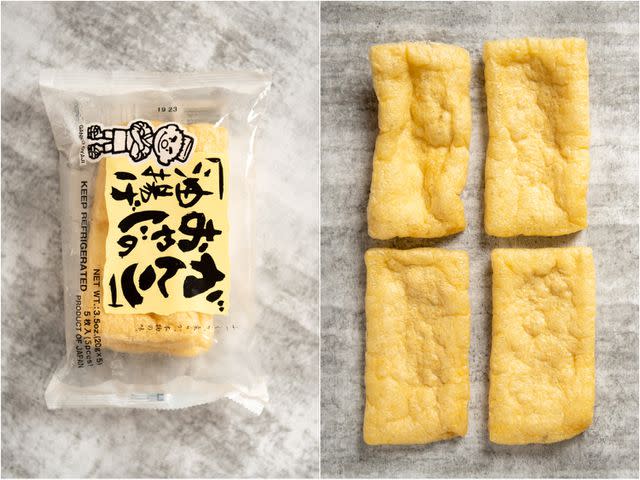
Liz Clayman
One last option, for extra credit: these sweet-and-salty prepared fried tofu pockets, called inari. This Japanese snack is made of deep-fried tofu, called aburaage, that's been puffed up and hollowed out, like a pita bread, then simmered in a sugar and soy sauce. Aburaage and inari both come pressed flat and, when cut in half, form pockets that can be stuffed with rice for inarizushi. This is a simple sushi style with a relatively uncomplicated execution. I personally prefer to just buy inari, as the at-home recipes I've tried never turn out to my liking, though some may find commercial inari too sweet. Aburaage and inari also make excellent additions to udon or soba soups.
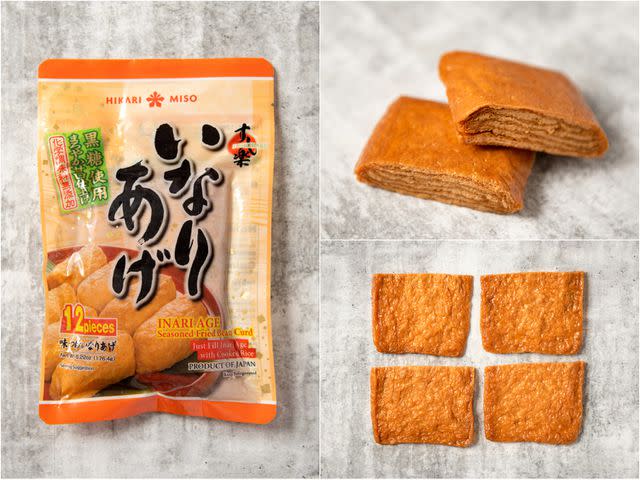
Serious Eats / Liz Clayman
How to Prep: No prep needed; simply remove the package and go.
Best Uses: Stuffed with sushi rice or added to brothy soups.
Aburaage and Inari Recipes:
Inarizushi
Vegan Tofu and Herb Salad
June 2014
Read the original article on Serious Eats.

